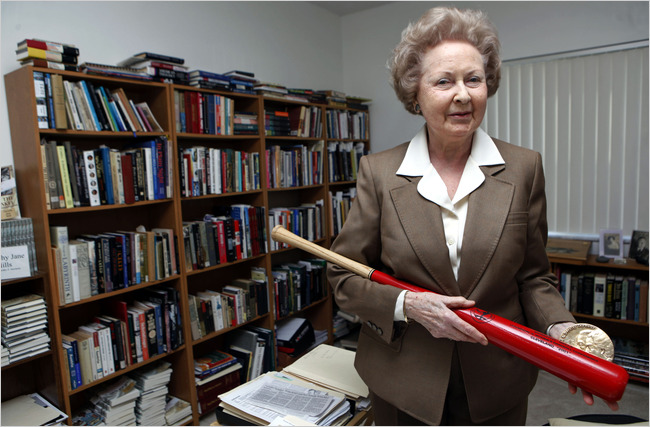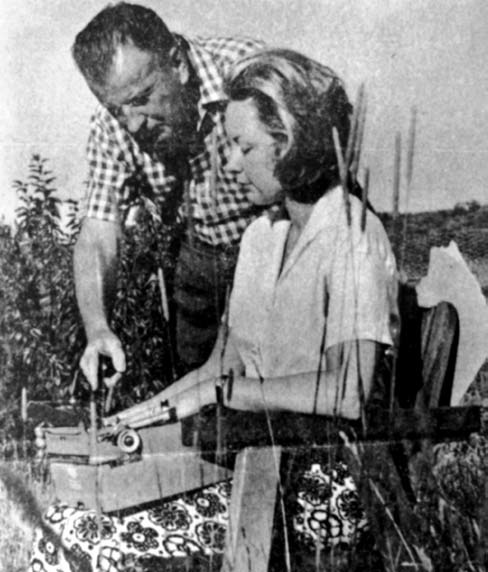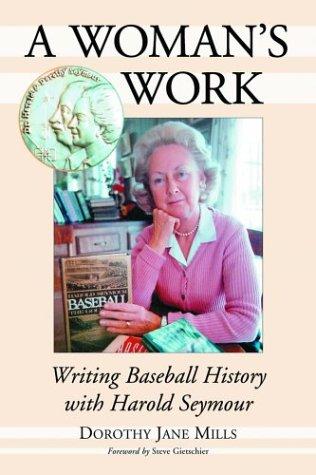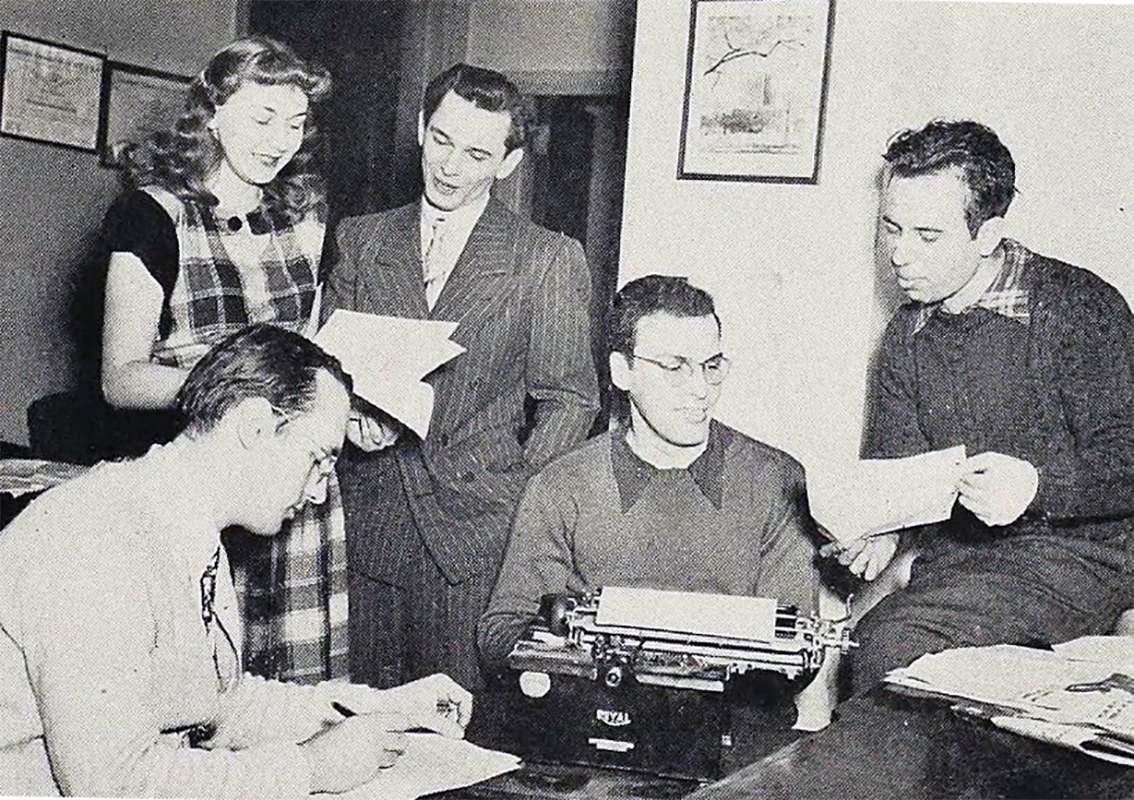In Memoriam: Dorothy Seymour Mills

Dorothy Seymour Mills poses in her office in 2010 for a New York Times profile of her work as a baseball historian. (COURTESY OF DOROTHY SEYMOUR MILLS)
By Jacob Pomrenke and Nicholas Hedges
Dorothy Seymour Mills’s interest in baseball was “purely academic,” she liked to say, but her contributions to the sport as its first female historian were groundbreaking and influential.
She was recognized in the inaugural class of recipients for SABR’s Henry Chadwick Award, honoring baseball’s greatest researchers, and two other awards in her name, the Seymour Medal and a lifetime achievement award for women in baseball, were established by SABR. She died of complications from an ulcer at the age of 91 on Sunday, November 17, 2019, at St. Joseph’s Hospital and Medical Center in Tucson, Arizona.
For most of Dorothy’s life, her efforts to advance our collective understanding about baseball went unrecognized and underappreciated. It was not until the death of her first husband, Dr. Harold Seymour, in 1992 that Dorothy’s work finally began to emerge from the shadows. For nearly a half-century, she partnered with Seymour in the research, writing, and editing of the classic three-volume series called Baseball, published by Oxford University Press.
“No one may call himself a student of baseball history without having read these indispensable works,” wrote John Thorn, Major League Baseball’s Official Historian.
Their initial volume, Baseball: The Early Years (1960), was the first scholarly history of baseball ever written, based on Seymour’s doctoral thesis at Cornell University. The second, Baseball: The Golden Age (1971), brought the history of the game into the modern era. Both books were published under Harold Seymour’s name alone, and he received widespread acclaim for “opening the field of baseball as a subject for serious study,” as Dorothy later wrote in her autobiography, A Woman’s Work.
 But hers was “the invisible hand” who guided the entire series behind the scenes — making research trips to libraries around the country; organizing, outlining, and writing some of the material; and even taking time off from her job as a teacher to assist in the production of the first two books. She also typed and retyped Seymour’s entire 632-page dissertation, later reflecting that her level of assistance was “probably inappropriate.”
But hers was “the invisible hand” who guided the entire series behind the scenes — making research trips to libraries around the country; organizing, outlining, and writing some of the material; and even taking time off from her job as a teacher to assist in the production of the first two books. She also typed and retyped Seymour’s entire 632-page dissertation, later reflecting that her level of assistance was “probably inappropriate.”
By the time the final volume, Baseball: The People’s Game, was published in 1990, she had taken over as the series’ primary author as Seymour struggled with the effects of Alzheimer’s disease. Still, Seymour refused to acknowledge her contributions publicly. Oxford editor Sheldon Meyer wrote her a letter, lamenting, “It is certainly an injustice to you.”
Efforts to correct that injustice began soon after Seymour’s death. When SABR established the Seymour Medal in 1996 to honor the best baseball book of the year, the bronze medallion’s design included profile images of both Harold and Dorothy in a nod to her unrecognized work. In 2010, Oxford University Press reissued the Baseball books with Dorothy listed on the front cover as a co-author. That same year, SABR announced Harold Seymour — but not Dorothy — as one of its first Henry Chadwick Award honorees. The selection committee quickly amended its decision after a public outcry and included them both as a joint recipient.
“Everyone assumed he had done all that work by himself — that’s what he wanted them to assume, but we were equal partners,” Dorothy told the New York Times. “All these things were done jointly. He just couldn’t share credit. And I didn’t say anything at the time, because at the time, wives just didn’t do that.”
Dorothy Jane Zander was born on July 5, 1928, in Cleveland, Ohio, the daughter of Henry and Katherine Zander. She and her brother Richard enjoyed spending their summer nights at Euclid Beach Park’s glamorous dance hall. Dorothy grew up drawing sketches and playing piano, but above all she loved to write, co-editing her high school newspaper and later working as a copy boy (“not a copy girl”) at the Cleveland News.
She became the first member of her family to go to college, enrolling at Fenn College (now Cleveland State University) to pursue a journalism career before switching her major to English. One of her professors was Harold Seymour, who was working toward his Ph.D. at Cornell University at the time. Impressed by her editorial skills, Seymour asked Dorothy to assist him in his work, although she had little interest in his dissertation topic, the early history of baseball.
It didn’t take long for Dorothy and Seymour to find a connection beyond the classroom. The day after Seymour’s divorce was finalized, they were married in 1949. Reluctant to continue her studies as both a student and a faculty wife, Dorothy instead transferred to nearby Western Reserve University. After graduation, she began teaching and writing children’s books while working on her master’s degree. One of her most popular books was the beloved classic Ann Likes Red (1965).
Beyond her personal pursuits, Dorothy became Seymour’s primary research assistant, first for his dissertation and then for his books. Seymour’s groundbreaking work on baseball history was making national headlines and she was working alongside him every step of the way. She grew to love the research process, which she compared to an exciting treasure hunt. Dorothy later wrote, “My star has always been outshone by Seymour’s, and I permitted this to happen. I even believed and told him, ‘Your work is more important than mine.’ That was like saying, ‘You are more important than I am.’ ”
 The first two Baseball books became instant classics, dispelling some of the most widely believed myths about the sport. After moving to New York City and then to Boston, where she worked as a senior editor at an educational publishing house, Dorothy convinced Seymour to quit teaching full-time. They then moved to Ireland for a few years to work on the third volume in the series. By the early 1980s, she was performing “most of his work for him,” while continuing to write her own children’s books and work in the publishing industry. Still, she was not listed on The People’s Game title page as a co-author and Seymour died in 1992 without ever acknowledging her role in his success.
The first two Baseball books became instant classics, dispelling some of the most widely believed myths about the sport. After moving to New York City and then to Boston, where she worked as a senior editor at an educational publishing house, Dorothy convinced Seymour to quit teaching full-time. They then moved to Ireland for a few years to work on the third volume in the series. By the early 1980s, she was performing “most of his work for him,” while continuing to write her own children’s books and work in the publishing industry. Still, she was not listed on The People’s Game title page as a co-author and Seymour died in 1992 without ever acknowledging her role in his success.
On a cruise in 1993, she met Roy Mills, a widower and retired officer with the Royal Canadian Air Force. They hit it off and two years later they were married. Dorothy told CNN that she “learned for the first time” what it was like to have a supportive partner in her life. She and Roy enjoyed traveling together and lived in Naples, Florida, until his death in 2012.
During this time, she also completed one of her biggest personal writing projects, The Sceptre, a historical novel set in Nazi-occupied Austria that she began working on when Seymour was alive. She later turned it into a trilogy, one of more than 30 books she published in her life on a wide range of interests, from baseball to education to vegetarian cooking. She also completed a series of satirical novels on the joys and perils of assisted living, based on her experiences at her longtime home of The Carlisle community in Naples.
Dorothy’s long-overdue recognition by the baseball research community, especially the decision by Oxford University Press to reissue the Baseball series with her name as co-author, brought needed closure to a complicated past that she called “at once glorious and ignominious.” She continued to write and give speeches all over the country, including at the annual Seymour Medal banquet in Arizona, where she most recently resided in an assisted-living facility near Tucson.
“Over the years, people have often brought their copies of the Seymour books to me and asked me to sign them,” she said in 2011. “So I [knew] they realized all the work I had done. After I published my autobiography, I said, ‘Even if they never put my name on a book, at least everybody knows.’ … But I’d always had that pride, you know. It was wonderful to know that a lot of people would realize I had such a role in those books.”
She is survived by four stepchildren, David, Kenneth, Donald, and Mary Jane; and six grandchildren, who were a big part of her life. She was predeceased by her husbands Dr. Harold Seymour and Roy Mills; her parents, Henry and Katherine Zander; and her brother, Dr. Richard H. Zander. Memorial services are pending.
Related links:
- Read John Thorn’s profile of Harold and Dorothy Seymour in the SABR Baseball Research Journal
- Click here to read our interview with Dorothy Seymour Mills in June 2011
- Learn more about the Dorothy Seymour Mills Lifetime Achievement Award for women in baseball
- Learn more about the Dr. Harold and Dorothy Seymour Medal
- “A Baseball Wife Emerges From the Dugout,” by Ann O’Neill (CNN.com)
- “A Woman’s Work: Doing Baseball History with Harold Seymour,” by Dorothy Seymour Mills

Dorothy Zander, top left, works on the Fenn College newspaper as a sophomore in 1948. Later known as Dorothy Seymour Mills, she became the first female baseball historian, co-authoring the classic three-volume “Baseball” series with Dr. Harold Seymour. (ANCESTRY.COM)
Originally published: November 19, 2019. Last Updated: December 23, 2025.


